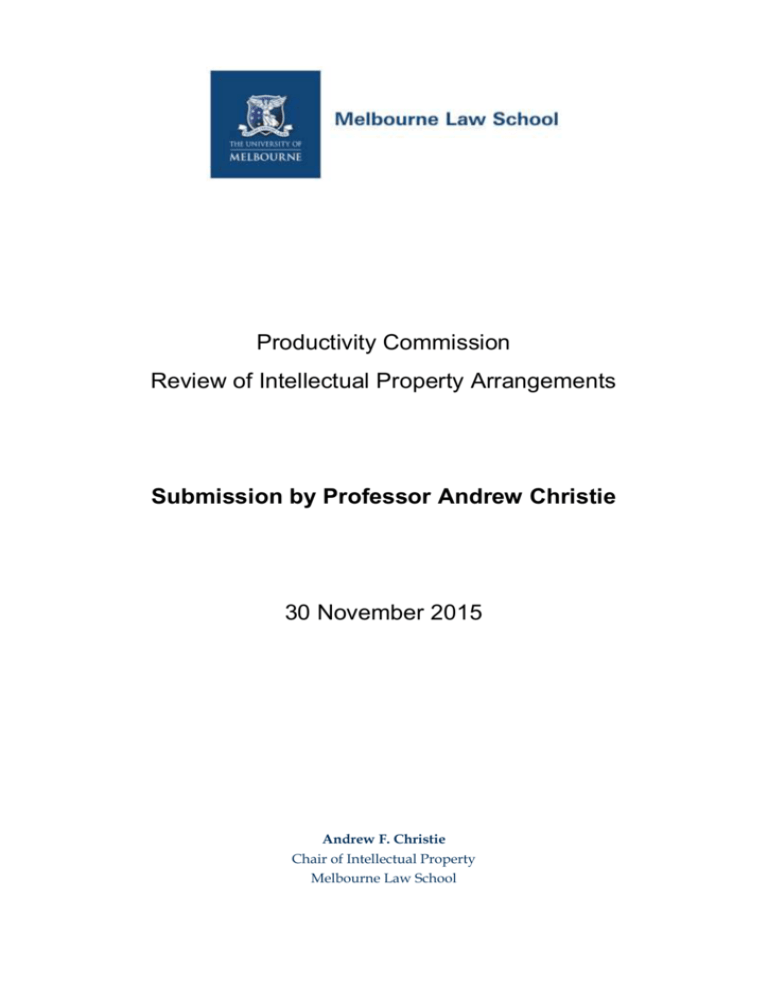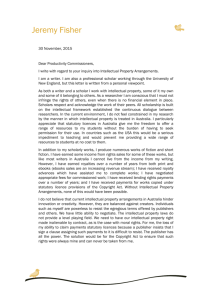Submission 29 - Prof Andrew Christie
advertisement

Productivity Commission Review of Intellectual Property Arrangements Submission by Professor Andrew Christie 30 November 2015 Andrew F. Christie Chair of Intellectual Property Melbourne Law School SUMMARY 1. Australia’s IP policy-making suffers from fragmented responsibility and an absence of independent expert input. There should be reform to portfolio responsibility to provide consolidation of – or, at least, substantial co-operation in – policy-making for all the IP regimes. The trend towards abolition of bodies providing independent expert advice to government on IP should be reversed – which the establishment of a body having a diverse expert membership to provide informed, frank and fearless advice to government on all key issues of IP policy. 2. Australia fails to deliver on the promise, implicit in the provision of a sophisticated system for the grant of IP rights, that there will be an accessible system for enforcement of those rights in the event they have been transgressed. Alternative, non-curial, fora for resolving IP disputes should be implemented. Reforms should be made to the court system along the lines of those taken in the UK to implement the Intellectual Property Enterprise Court. QUALIFICATIONS I make this submission in my individual professional capacity – that is, as an academic and professional lawyer with more than 30 years’ experience in intellectual property matters. I have held teaching and research positions at law schools around the world, including at Duke University, the National University of Singapore, the University of Cambridge, and the University of Toronto. Since 2002, I have held the Chair of Intellectual Property in the Melbourne Law School. I am admitted to legal practice in Australia and the United Kingdom, and I worked for a number of years in the intellectual property departments of major law firms in Melbourne and London. I have been appointed to Ministerial advisory committees on IP by both sides of parliament: the Copyright Law Review Committee (1995-1998), the Advisory Council on Intellectual Property (2002-2010), and the Plant Breeder’s Rights Advisory Committee (2013-current). SUBMISSION I confine my submission to two issues, both of which relate to Section 5 of the Issues Paper: (i) the institutional landscape for IP policy-making; and (ii) the enforcement of IP rights. Submission of Professor Andrew Christie Page 2 of 5 Institutional Landscape for IP Policy-Making Australia’s policy-making in IP suffers from fragmented responsibility and an absence of independent expert input. The problem of fragmented responsibility and an absence of independent expert input is particularly acute in respect of copyright. Responsibility for copyright policy is located in the Department of Communications and the Arts (following its relatively recent move from the Attorney-General’s Department), separated from the other major IP regimes for which responsibility rests in IP Australia (an agency of the Department of Industry, Innovation and Science).1 The separation of responsibility for copyright from responsibility for patents, trade marks, designs and plant breeder’s rights inevitably has the effect that policy for copyright is developed largely ignorant of the policy, principles and practices of the other IP regimes – meaning an holistic view of IP policy is missing. Following the abolition of the Copyright Law Review Committee (CLRC) in 2005, there has been no standing body providing meaningful independent expert advice on copyright policy to government. It is not coincidental that the decade following the abolition of the CLRC is one in which poor policy-making (or, more accurately, the absence of good policy-making) in copyright has occurred. At least part of the reason Australia has a poor record of copyright reform in the past decade is due to the absence of independent expert advice. While responsibility for the other major IP regimes is not fragmented, the problem of an absence of independent expert input exists to some degree. Following the abolition of the Advisory Council on Intellectual Property (ACIP) and the Plant Breeder’s Rights Advisory Committee as a result of implementation of the Commission of Audit’s recommendations, there will be no standing independent expert body providing input on IP policy. While it is true that IP Australia regularly convenes “working groups” to provide input into patents, trade marks and designs, these working groups are almost exclusively comprised of practitioners (lawyers and attorneys) and are confined largely to consideration of micro-level issues of practice. The ability for the working groups to provide a broader perspective (including from economics, industry and civil society) at the macro-level on policy-oriented issues is very limited. A number of reforms should be undertaken to remedy these deficiencies. First, there should be reform to portfolio responsibility to provide consolidation of – or, at least, substantial co-operation in – policy-making for all the IP regimes. The options for such reform include locating responsibility for all IP regimes in one agency (the only 1 It is recognised that responsibility for circuit layout protection and geographical indications lies elsewhere – in the Department of Communications and the Arts, and the Wine Australia Corporation, respectively. However, these IP regimes are not considered major ones. Submission of Professor Andrew Christie Page 3 of 5 realistic prospect for which is IP Australia) and/or designating a single Minister to have responsibility for all IP regimes. Secondly, the trend towards abolition of standing bodies providing independent expert advice to government on IP should be reversed. A body similar in operation, responsibility and membership to the recently-abolished ACIP should be established, to provide informed, frank and fearless advice to government on all key issues of IP policy-making. The existence of such a body will be particularly important if policymaking responsibility for all IP regimes is given to IP Australia, since its agency status makes it effectively one-step removed from government. Enforcement of IP Rights Australia has a sophisticated system of IP laws, providing strong exclusive rights to creators, innovators and entrepreneurs whose endeavours satisfy the requirements for protection to arise under the various IP regimes. The provision of this system of IP laws carries an implicit promise – namely, that there will be available an accessible system for enforcement of those rights in the event they have been transgressed. Australia fails to deliver on this promise. While it has a well-developed court system in which IP disputes can be heard, the costs (time and money) involved in bringing and defending an action in the courts is such as to mean, for the vast majority of parties in the vast majority of disputes, the system is out-of-reach. Put another way, the substantial cost involved in litigating an IP dispute in court means that, in practice, court action to enforce (or to defend) infringement of rights is not a realistic option most of the time. It is important that this problem be remedied, otherwise the objective of providing IP rights will not be met. Having rights that cannot be enforced is the practical equivalent of having no rights at all.2 A number of reforms should be undertaken to remedy this position. First, alternative, non-curial, fora for resolving IP disputes, along the lines of those recommended by ACIP in its 2010 Review of post-grant Patent Enforcement Strategies,3 should be implemented. Secondly, reforms should be made to the court system, along the lines of those taken in the UK to implement the Intellectual Property Enterprise Court4 – an initiative which the evidence suggests 2 This point applies equally to alleged infringers as it does to IP right-holders. Parties other than an IP rights-holder can be considered to have “rights” (in the sense being considered here) under IP laws – e.g. the right to undertake a fair dealing with a copyright work, or the right to undertake an act with a patented invention for experimental purposes. Where an alleged infringer claims to have the “right” to do the thing that is allegedly infringing, that right is nugatory if the cost of defending the infringement action is so great as to mean defending it is not practically possible. 3 http://www.acip.gov.au/reviews/all-reviews/review-patent-enforcement/. Submission of Professor Andrew Christie Page 4 of 5 has had significant success in allowing parties to resolve IP disputes that otherwise could not have been taken to court.5 See The Hon. Mr Justice Birss, ‘To boldly reform IP dispute resolution: experience in the IP Enterprise Court’, 2015 Francis Gurry Lecture on Intellectual Property, http://achristie.com/wpcontent/uploads/2015/11/Francis-Gurry-Lecture-2015-prepublication-version.pdf. 4 See Helmers, Lefouili and McDonagh, ‘Evaluation of the Reforms of the Intellectual Property Enterprise Court 2010-2013’, https://www.gov.uk/government/uploads/system/uploads/attachment_data/file/447710/Evaluation_ of_the_Reforms_of_the_Intellectual_Property_Enterprise_Court_2010-2013.pdf. 5 Submission of Professor Andrew Christie Page 5 of 5







